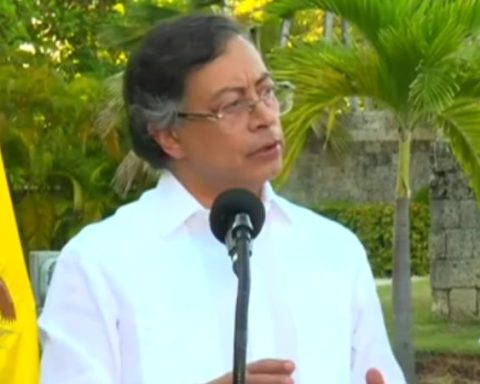The National Planning Department presented the results of the Fiscal Performance Index (IDF) for the 2023 period of the 1,101 municipalities of the national territory, where increasing collection and facing an expensive debt, which had to be acquired during the pandemic, are two challenges that remain on the horizon, despite notable improvements compared to previous periods.
According to this entity, the IDF was 56.67 points on average nationwide, mainly as a result of the efforts that municipalities have been making to optimize the indicators of fiscal results and financial management, which determine the general index; in aspects such as debt, income and tax collection, among others.
More news: Informality and public spending in Colombia are a concern for the OECD
“This is a measurement that evaluates the performance of the financial management of territorial entities based on two components, the first, the fiscal results, which is equivalent to 80% of the weighting,” explained the DNP, which stressed that data like these are an important input when making decisions. decisions in the regions that aim to promote development and overcome poverty.
In this regard, the Deputy Director General of Decentralization and Territorial Development of the DNP, Elizabeth Correa Soto, explained that on this occasion the ranking reflects “important advances such as the increase in own income, despite the high dependence on transfers from the Nation, which on average add up to more than 60% of the income of the municipalities of the country.”
Debt
iStock
“In the disaggregated analysis of fiscal performance, Bogotá stood out as the city with the best results in the group of cities, reaching 88.1 points out of 100. At the municipal level, Nobsa (Boyacá) led in Group 1 with 83.79 points, followed by Chipaque (Cundinamarca) in Group 2, with 79.43 points, and Oiba (Santander) in Group 3, with 76.86 points,” said Correa Soto.
This official added that in Group 4, Buriticá (Antioquia) obtained 72.07 points, while in Group 5, Litoral de San Juan (Chocó) reached 76.97 points. These municipalities stood out for their fiscal management, reflecting significant differences in the capacity to manage public resources between the different regions of the country.
Debt interest
According to the report, municipalities and cities in Colombia currently have debts of more than $22.5 billion. This value, in the records of National Planning, translates into a reduction of approximately $500,000 million compared to the balance of $22.6 billion that was observed at the end of 2022. While this seems good at first glance, it generates concern when The range of data is expanded and shows that between 2012 and 2023 this item has increased by 173%.
You may be interested in: Once again, the National Budget would be exposed to vices of unconstitutionality
“The comparative analysis of the municipalities, carried out through the Fiscal Performance Index Measurement, allows for an objective evaluation of their performance considering the Initial Capabilities methodology that classifies the municipalities into six groups. These capacities are measured based on variables such as business density, added value, population size and percentage in municipal capital, agglomeration economies and territorial income,” added the DNP.

Municipalities
Properati
On the other hand, as regards the state of debt in the regions, It was also learned that 67% of the debt is concentrated in four cities: Bogotá (40%), Barranquilla (13%), Medellín (9%) and Cali (5%), which reiterates the theory that most of the country’s economic movement continues to occur in the populations that are part of the center, especially in Bogotá, whose debt represents four out of every $10 pesos.
Likewise, last year the municipalities accumulated a debt payment of $4.65 billion, of which the vast majority went to interest, which rose 54% from $1.89 billion in the previous report to $2.91 billion, while payments associated with amortizations increased 17%, going from $1.49 billion to $1.74 billion.
Backward regions
To better understand the reality of the regions, the National Planning Department established a series of categories for the municipalities, starting with “deterioration” and “risk”, where those populations with risks of deficit or that present high indebtedness are found; in addition to the fact that it dependsThey depend largely on state transfers and report low levels of private investment.
Read also: What is known about Rappi’s possible entry into the New York Stock Exchange?
“The Caribbean region (196 municipalities) has a concentration of municipalities in the deterioration range (preponderance of 7.65%, while the national average is 2.72%) and a significant percentage in the risk range (preponderance of 70.41%),” they noted in this regard.
This list also includes the category of “vulnerable” cities, which are those or municipalities that comply with legal debt and expenditure limits, but still depend significantly on transfers and maintain low levels of investment in gross fixed capital formation, which limits their sustainable growth.

Poverty
EFE
“The Central East region (367 municipalities) shows a high concentration of municipalities in the vulnerable range (39.0%), while solvent (6.8%). Cundinamarca (66.4%) and Santander (42.5%) have the highest proportion of municipalities in these ranges,” can be seen in this report.
Finally, the solvent group includes territories that present healthy finances, although they still have opportunities for improvement in some of their indicators, followed by sustainable municipalities, which are characterized by attracting large capitals and generating development without depending on economic transfers, which gives them a greater capacity to provide goods and services in the long term.
“It is evident that municipalities have shown increases in the generation of their own resources (2012-2023), however, there is still a high dependence on transfers from the nation. Own revenues can increase by improving territorial fiscal management,” they concluded in the report.
National Planning closed by reminding that to improve this it is It is necessary to advance a process of continuous monitoring by the governorates to closely follow the fiscal results of the municipalities and strengthen the training and technical assistance programs and improve territorial articulation with the Nation.


















